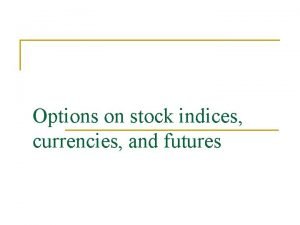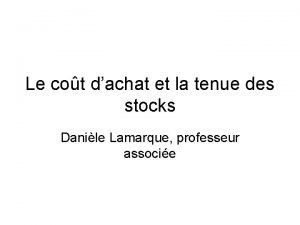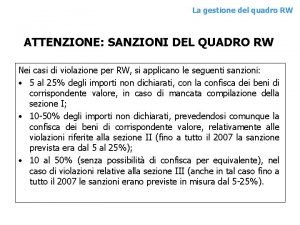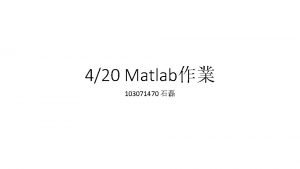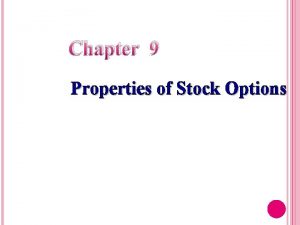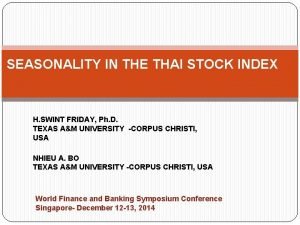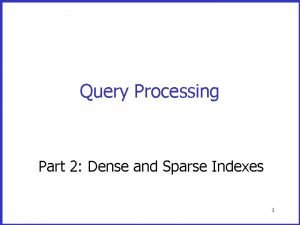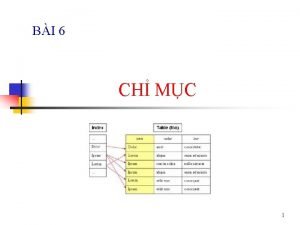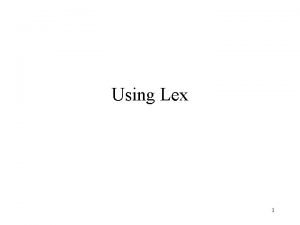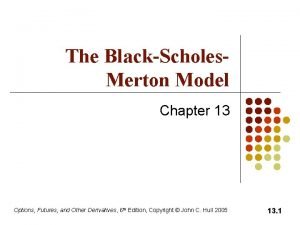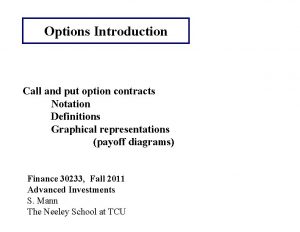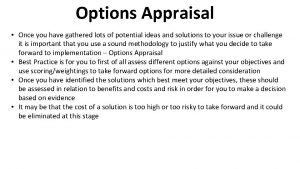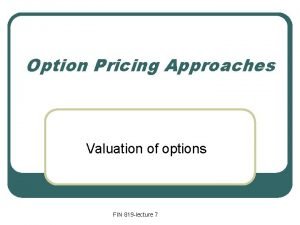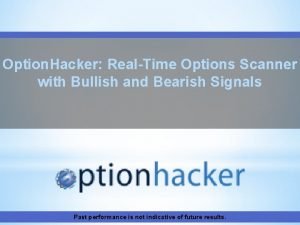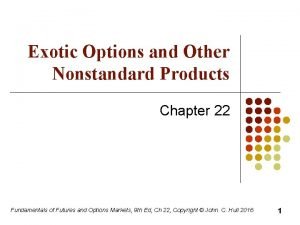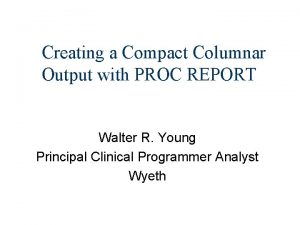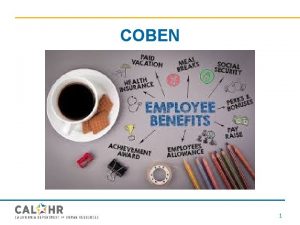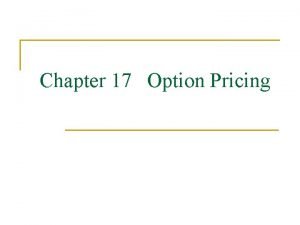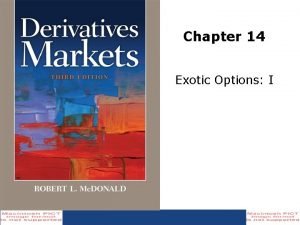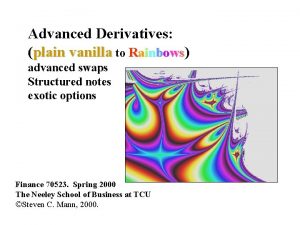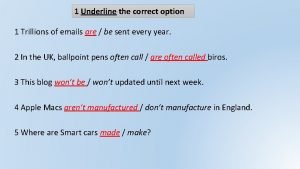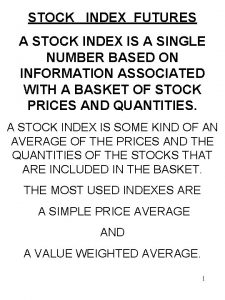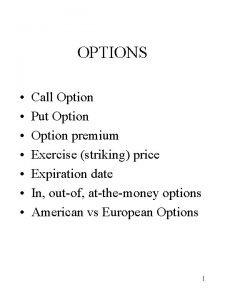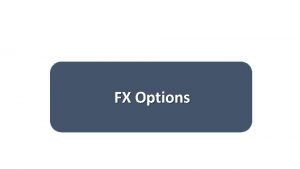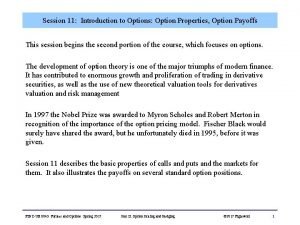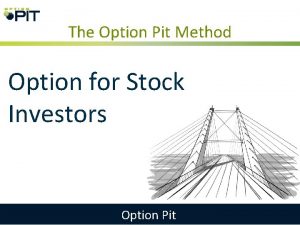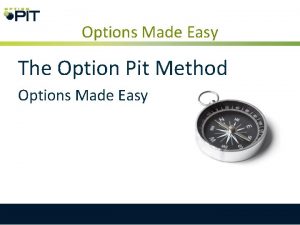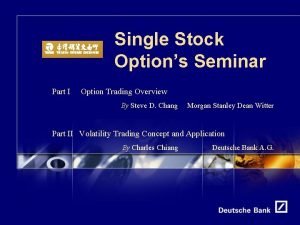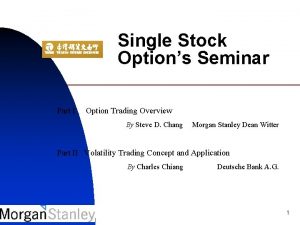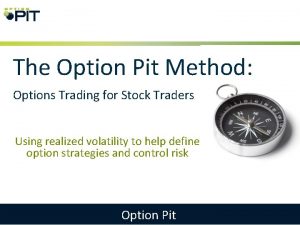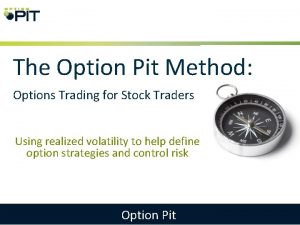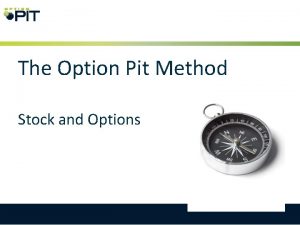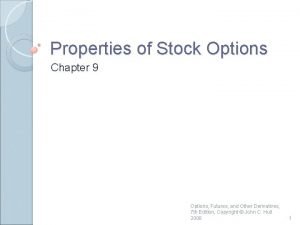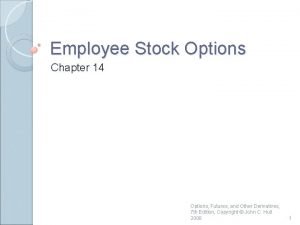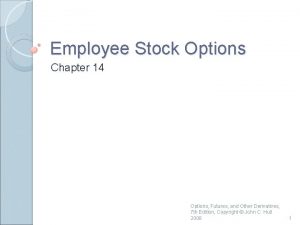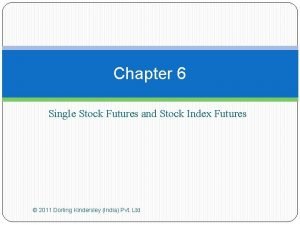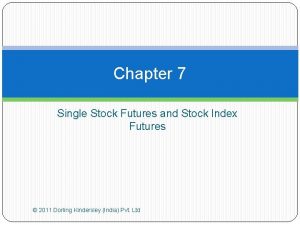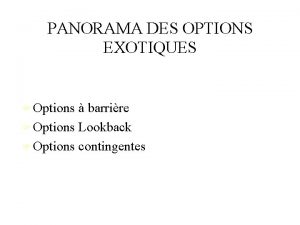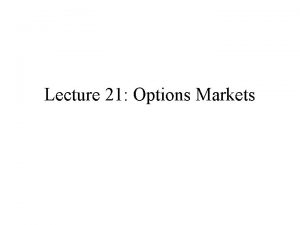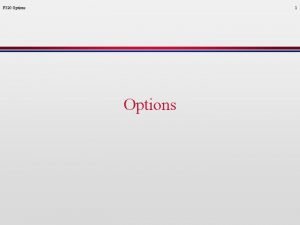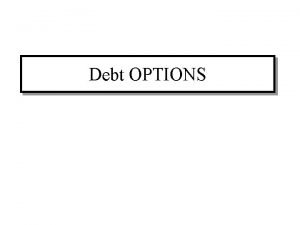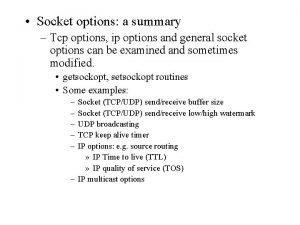Stock Index Options Chapter 9 Stock Index Option













































- Slides: 45

Stock Index Options Chapter 9

Stock Index Option • Options on stock indices: S&P 500, S&P 100, and MMI. • Features: – Cash Settlement: when you exercise, the assigned writer pays you the difference between the closing (spot) index (S) and the exercise price; Call: S-X; Put: X-S. – Multiplier: $100. – End-of-the-day exercise

Uses • Speculation: – Bullish: long in call – Bearish: long in put – Stable market: short • Portfolio Insurance

Portfolio Insurance • An important use of stock index options is portfolio insurance. This is a hedging strategy in which an equity portfolio manager protects the future value of her fund by buying index put options. – The put options provide downside protection against a market decline, while allowing the fund to grow if the market increases.

Portfolio Insurance Example – Suppose a fund manager has a $50 M portfolio that he may have to liquidate in September. The fund is well-diversified with a beta of 1. 25. The current S&P 500 is at 1250, and there is a September S&P 500 put with an exercise price of 1250, multiplier of 100, and trading at 50. – To form a portfolio insurance position, the manager would need to buy 1. 25(50 M)/X =500 puts at a cost of $2. 5 M= (100)(50).

Put-Hedged Portfolio at T

Fiduciary Call • If the manager knew he was going to liquidate in September, he could sell the portfolio and invest the proceeds in a RF security and buy a call option. • Assume the September option expires in six months, Rf = 6%, and the put-call parity holds:

Fiduciary Call • • Strategy: Liquidate the portfolio for $50 M. Invest $50 M in RF security at 6% for 6 months. Buy 500 calls:

Fiduciary Call

Pricing Index Options • The B-S model and the BOPM are defined by a replicating portfolio. For an index option, the replicating portfolio is a stock portfolio consisting of all the stocks in the index or a proxy portfolio formed with fewer stocks that are highly correlated with the index (maybe a MF). • Later we will define it in terms of a index futures position.

Proxy Portfolio • A proxy portfolio can be viewed as a position in the index. • For example, suppose you have a proxy portfolio worth Vo = $1. 5 M and the S&P 500 index is at So = 1250. • The proxy portfolio would be the equivalent of buying n = $1. 5 M/1250 = 1200 index shares at $1250 per share.

BOPM • Consider single-index BOPM with u = 1. 0227, d =. 9778, Rf =. 005, So = 310, X= 310.

Black-Scholes Model for Index Options • The most common way to price index option using the B-S model is to use the continuous dividend adjustment model where Sd is used instead of So. • Note: BAW model may be a better model for pricing index options.

Dynamic Portfolio Insurance • Because of the position limits on options, a portfolio insurance strategy formed with index put options may not be applicable for large portfolios. • An alternative is to use a dynamic portfolio insurance strategy using a stock and bond portfolio which is managed over time using a binomial framework. • Consider a portfolio which is highly correlated with a stock index that is currently at So = 150. Assume u = 1. 1, d = 1/1. 1 =. 9091, Rf =. 05, and n = 2. • As show in the figure, with portfolio insurance one could obtain portfolio values of 3. 025 M if the market increases and 2. 5 M if its stays at 150 or declines.


Dynamic Strategy Objective • Objective: Construct a bond and stock portfolio and manage it in such a way that you will have possible CFs of 3. 025 M, 2. 5 M, and 2. 5 M given the three possible spot index values at the end of period 2.

Dynamic Strategy Methodology • Define the portfolio as an investment in hypothetical shares of the stock index. • Form a bond and stock portfolio consisting of a diversified stock portfolio and an a investment in RF security (Io)


Dynamic Strategy Methodology • Period 1: • If the stock and bond portfolio is worth Vu = $2. 75 M when Su = 165, then it could be converted to all stock and reach next period’s target of being either 3. 025 M or 2. 5. • If the stock and bond portfolio is worth Vd = 2. 5 M/1. 05 = 2. 381 when Sd = 136. 3636, then the portfolio could be converted to all bonds and hit its target next period of 2. 5.

Dynamic Strategy Methodology • Mathematically, our problem is to solve for the n and Io where:

Dynamic Strategy Methodology • Solution:


Foreign Currency Options Chapter 10

Foreign Currency Options • Currency options are traded on the Philadelphia exchange (PHLX) and on exchanges in Toronto, Montreal, and Amsterdam. There is also a Dealer’s Market that is part of the Interbank FC market. • PHLX offers trading in: BP, DM, JY, SF, FF, AD, and CD. See JG, pp. 305 -307 for features of FC options.

FC Put-Call Parity • Conversion:

FC Put-Call Parity • At T position will be worth X.

FC BOPM • BOPM for FC is similar to that for stock except that a foreign interest rate is included. • The replicating portfolio consists of buying Ho units of FC at Eo and borrowing Bo dollars. The Ho units of FC can be invested for the period in a foreign RF security.

FC BOPM • Single Period

FC BOPM • Solve for Ho and Bo where:

FC: B-S Model • Use Ed instead of Eo:

FC Options Use • Speculation on Exchange rates • Hedging future FC payment or receipt positions

Hedging Currency Positions – Suppose a U. S. investment fund is expecting 625, 000 DM in September from its Eurobonds. – The Fund expects the exchange rate to increase from its current level of Eo =$. 40/DM, suggesting greater dollar revenues than $250, 000, but it is not confident. To benefit from an increase in Eo, while hedging against an Eo decrease, the fund buys 10 DM put contracts with X=$. 40, P=$. 01, size=62500 DM.

Hedge DM Revenue at T

Hedging Currency Positions – Suppose a U. S. Company has a 625, 000 DM debt to be paid in September. – The company expects the exchange rate to decrease from its current level of Eo =$. 40/DM, suggesting lower dollar cost than $250, 000, but it is not confident. To benefit from a decrease in Eo, while hedging against an Eo increase, the company buys 10 DM call contracts with X=$. 40, C=$. 01, size=62500 DM.

Hedge DM Cost at T

Options Issued by Corporations Chapter 11

Warrant – A warrant is a call option issued by a Corporation. – The contractual features of a warrant and a call are the same. – The primary difference between a warrant and a call is that the writer of the warrant is the issuing corporation. – If a warrant is exercised, the corporation receives cash and creates new shares -- dilution effect.

Warrants Example – Example: LM Co. is a $100, 000 oil well company; all equity, with 100 shares outstanding and with each share worth $1000; has 4 shareholders, A, B, C, and D, each with 25 shares. – Consider alternatives: Shareholder D sells a call option to investor E, giving her the right to buy 25 shares at X = $1100/share; the LM Co. sells a warrant with the same features.

Oil Well Increases in Value • Oil Well increases in value to $120, 000, causing LM stock to go to $1200. • Call Exercised: – When Investor E exercises, shareholder D will simply turn over his 25 shares for $1100/share. – Exercising has no impact on the value of LM. – IVc = $1200 -$1100 = $100.

Warrant Exercised – When E exercises her warrant, the LM Co. will have to print 25 new shares (Nw) and sell them to E at X = $1100/share. – The company will receive cash, but the number of shares will increase: • 100 to 125 shares (dilution) • ($1100) (25) = $27, 500 – In this case, the exercise of the warrant lowers the value of the stock from $1200 to $1180.

Warrant Value Stock and Warrant Values:

Warrant and Call Relation • Relation: The value of the warrant is equal to the value of the call times the dilution factor:

Rights – Definition: A right is call option issued by a corporation to existing shareholders, giving the holder the right to buy new shares at a specified price (subscription price). – Corporations use rights to ensure they adhere to preemptive rights. – A right is like a warrant: when it is exercised, new shares are created and the company receives cash.

Rights Example ABC company is planning to raise $20 M in equity to finance a capital acquisition. The company is worth $200 M, has no debt, and has 1 million shares of stock outstanding, with each share currently trading at $200. ABC plans to finance its $20 M investment with a rights offering in which it gives shareholders the right to buy new shares at $160, with each holder receiving one right for each share owned.

Value of the Right Number of new shares = Number of Rights for 1 Share = Stock Value IV of Right
 Konvergensi option adalah
Konvergensi option adalah Long call short call
Long call short call Bagaimana cara pencatatan pembatalan untuk stock option
Bagaimana cara pencatatan pembatalan untuk stock option Options on stock indices and currencies
Options on stock indices and currencies Tenue des stocks
Tenue des stocks Stock option quadro rw
Stock option quadro rw Index currency option notes
Index currency option notes Gigaplex academy
Gigaplex academy Properties of stock options
Properties of stock options Chapter 3 foodservice career options
Chapter 3 foodservice career options Long-term debt preferred stock and common stock
Long-term debt preferred stock and common stock White stock dan brown stock
White stock dan brown stock Common stock characteristics
Common stock characteristics Stock final de marchandises
Stock final de marchandises Thai stock market set index series
Thai stock market set index series Optical fibre
Optical fibre Dense secondary index
Dense secondary index Bacteriological index formula
Bacteriological index formula Compare india and sri lanka on the basis of hdi
Compare india and sri lanka on the basis of hdi Mode theory of circular waveguide
Mode theory of circular waveguide Simpson diversity index example
Simpson diversity index example Consistency limit test
Consistency limit test Clustered index và non clustered index
Clustered index và non clustered index Yield to worst
Yield to worst Vbscript option explicit
Vbscript option explicit Flex (lexical analyser generator)
Flex (lexical analyser generator) Black-scholes-merton model
Black-scholes-merton model Preferential option of the poor
Preferential option of the poor Option premium
Option premium Option bond
Option bond Options appraisal template
Options appraisal template Put price formula
Put price formula Options scanner
Options scanner Ltcm wiki
Ltcm wiki Fossmap
Fossmap Factors affecting option premium
Factors affecting option premium Cliquet option
Cliquet option Proc report flow
Proc report flow Coben cash
Coben cash Circle the correct option.
Circle the correct option. Dut informatique option imagerie numérique
Dut informatique option imagerie numérique Put option formula
Put option formula Gap options
Gap options Plain vanilla derivatives
Plain vanilla derivatives Knock in knock out option
Knock in knock out option Underline 1 +1=
Underline 1 +1=



